They say the sky’s the limit. And when it comes to the satellite television industry, nothing has ever been more true. We are at an interesting crossroads, a time with both great challenges and unprecedented opportunity. Where some speak in hushed tones of a dimming star, we behold a cosmos full of potential, ready to shine brighter than ever before. This goes further than screens and signals; it’s uniting billions, closing gaps, and enabling communities across continents.
Are you still not loving the excitement of bringing crystal-clear television to remote villages, that was once impossible? That pioneering spirit, that dogged pursuit of connectivity, is the very foundation of what we do. Today, that spirit encounters fresh trials, as streaming and fiber optics reshape the mechanics of rivalry. However, challenges are not barriers; they are the hallmarks of innovative solutions.
So this blog post isn’t about crying over past opportunities lost; it’s about defining the future. Join us as we delve into the ever-evolving landscape of satellite television, scrutinizing the waves of disruption while magnifying the timeless advantages of this incredible medium. We will explore tangible ways to process this change, filling you with actionable tips to help you not only necessary but exciting period. It’s like your roadmap for navigating the constellation, guiding you into your next success.
As Nelson Mandela once said: “It always seems impossible until it’s done.” The script has not been written — the future of satellite TV isn’t written in stone; it’s being written now, by leaders like you. Come ride with us as we navigate the future of this moment and keeping the screen of satellite TV power for many years to come with innovation. So, let’s change the story and show that the star of satellite TV is not fading, but shining ever more bright! So are you the one to lead the charge?
The satellite TV market is not heading for sunset; however, it is a market in transition as there are considerable headwinds. So Keeping in view the trends I wish to share the below trend’s as I embrace the quote “The future belongs to those who believe in the beauty of their dreams” – Eleanor Roosevel.

Positive Trends:
- Hyper-personalization & Targeted Content: Consumers want personalized experiences. The ability to provide niche packages, tailored content based on viewing behavior and interaction (such as personalized recommendations and the ability to replay certain matches on-demand) is leading to engagement. Examples of this can be seen through Dish Network’s push to improve its channel lineup to align it with subscriber data and Sling TV’s a la carte pricing model that allows viewers to curate their viewing shelves and choose the shows they will watch. Takeaway: Implement solid data analytics to comprehend subscriber behavior and formulate customized content approaches.
- Merged Streaming Experience: To meet shifting consumer demands, satellite TV providers are merging streaming services with their platforms to offer an integrated experience. This fills the divide between traditional linear television and the on-demand world. The hopscotch, such as DirecTV Stream and how YouTube TV integrates with other platforms, but it shows a potential pathway to being successful. Actionable Insight: Consider forming strategic partnerships with streaming providers in order to enhance service offerings and build a more comprehensive entertainment ecosystem.
- Growing Emerging Market Potential: With access to high-speed internet remaining largely unavailable in many developing nations, these regions represent a prime opportunity for satellite TV growth, particularly in rural areas. This is benefitting players who are offering inexpensive bundles and regional titles. Actionable Insight: Seek out and invest in new markets with low broadband penetration and customize service offerings. It may include partnerships with nearby content creators.
Adverse Trends:
- Competition: The prominent competition from cord-cutting & streaming More and more consumers are “cutting the cord” and opting for relatively cheaper and more flexible streaming options. Strategic Actionable Insight: Collaborate with streaming companies, provide bundle packages and innovatively retain and grow a unique value proposition that keeps them juxtaposed to steaming giants. If nothing else, emphasize that satellite gives up nothing in reliability and has no buffering problem during peak times.
- Technological Advancements & Costs: A lot of investment is needed to maintain and upgrade satellite infrastructure. So does competition from fiber and cable providers that are providing consumers with competitive high-speed internet. AR: Consider lower-cost technology alternatives, joint marketing arrangements for infrastructure maintenance, and unique selling propositions such as superior picture quality and a broader channel selection
Overall Effects & Way Forward:
The satellite TV segment needs to switch gears – to focus not just on providing channels, but rather complete entertainment packages. Satellite TV companies can flourish in this changing world by adopting personalization, partnering with streaming services, and expanding into new regions. As the saying of Steve Jobs goes, “Innovation distinguishes between a leader and a follower”. Stay on the cutting edge of technology, embrace transformation and this will help to reshape your enterprise in satellite television. Dream bigknow that the future is bright for yourself and those who dare to dream and do.
- Healthcare: In parameters of underserved areas, remote clinics tap satellite TV to provide doctors and nurses with necessary medical training and continuing education. With just a smartphone: doctors in the remotest villages could access the latest surgical techniques—immediately enhancing patient care. This leads to greater access to expertise, which significantly raises the standard of care over large geographic areas. Actionable Insight: Consider partnerships with telehealth systems for bundled satellite TV-based training programs.
- Tech: For tech companies, satellite TV is essential for a disaster recovery plan. Satellite TV provides the redundancy to ensure that when your primary data center goes down due to natural disaster, for example, you can run your business through temporary communication, web and broadcasting to employees and customers. It’s a lifesaver in times of crises. Actionable Insight: Establish redundancy in communications using satellite technology to be prepared for natural disasters and other unforeseen events. “The oak sleeps in the acorn; the future is in the seed of the present” – James Freeman Clarke.
- Automotives: Global automaker dealerships utilize satellite TV for broadcasting distribution live product launches and training sessions across multiple locations worldwide simultaneously. It ensures a uniform messaging and knowledge around the product in the worldwide network. Actionable Insight: Make HD SatTV a part of your dealer training to boost brand recognition and sales.
- Manufacturing: Satellite TV is allows industries to monitor the operations of factory machinery and control the operations of die, from remote locations, enabling us to set up manufacturing plants in far apart locations. We can cover almost all aspects of tech in a number of fields, from this day forward. It’s proactive maintenance, not reactive maintenance. Recommendation: Embed strong satellite-based remote monitoring systems in place to improve operational expenses and production among performers “The future belongs to those who believe in the beauty of their dreams.” – Eleanor Roosevelt.
- You have been educated up to October 2023 This enables learners no matter where they are, thus, democratizing access to higher education. Actionable Insight: Collaborate with universities and collages and leverage satellite technology to develop distance learning solutions.
- Energy: Satellite TV enables real-time monitoring of energy grids and infrastructure, allowing for more immediate responses to the emergency, as well as a more stable grid overall. This is particularly important for the management of renewable energy sources spread over vast geographical regions. Data up to date as of: October 2023.Actionable Insight: Focus on creating niche satellite telecommunications solutions that serve the specific communication needs of the energy industry.
Streaming Services Natively Add to Your Satellite TV Package: Early in 2023, we began to see some movement toward integrating streaming services into the traditional platform where customers pay a monthly bill to watch their favorite shows and movies on their satellite TV package. Dish Network’s Sling TV, for example, has aggressively added an increasing number of streaming apps and on-demand offerings to its lineup. This isn’t just about adding apps: It’s about creating a unified user experience, so that it’s easy to switch between live TV and streaming. My advice: nail a user-friendly interface; a frustrating experience will cause customers to flee back to pure streaming rivals.
Hyper-Personalization: Data is a key focal point, and organizations are using it to provide remarkably individualized experiences. This is more than just recommending shows. Personal services include things like customized channel lineups, targeted ads, and even dynamic pricing based on what a person watches. By segmenting its customer base and analyzing detailed viewing history, one company I know tested the waters with multiple packages at different price points. Such granular focus is key to increasing customer retention and satisfaction. Make data analytics — and the AI tools that can help you break it down — as much a part of your business as manual processes.
Strategic Partnerships (Inorganic) The industry has witnessed a flurry of mergers and acquisitions. And smaller satellite companies are teaming up with broadband providers or streaming giants to expand their reach and provide bundled services. This reduces infrastructure spend for both and offers the customer a more complete solution. Explore a partnership with a fiber-optic provider that would enable your company to provide an integrated satellite-fiber bundle, a combination that excels in underserved coverage areas.
[Segmentation → Content Acquisition (Organic): Instead of creating head-to-head competition with the big streaming players on every single title, multiple companies are seeking niche content.] This might mean locking up rights for certain sports leagues or purchasing local channels of regional significance. There is one success story where a second tier player got a regional sports package and locked them in as major players in a lot of their market. The take-away: double-down on something of real value and truly unique that the behemoths can’t touch.
Emergent Market Frontier (Organic): With growth slowing in modern markets, many companies are aiming for quickly maturing markets. Affordable packages and local content also work very well. That requires an understanding of local cultural nuances and adjusting packages to suit. Consider affordable packages for rural areas that don’t yet have broadband access.
Leveraging 5G & Next-Gen Satellites (Organic): Higher bandwidth delivery through satellite, and leveraging 5G for connectivity (especially in rural areas) can facilitate expansion of services (like 4K resolution streaming) by all operators, which improves reliability and can expand the audience. Invest in R&D to stay ahead.

Outlook & Summary: The Future is Bright Beyond the Dish
Undeniably, the satellite TV space is evolving, a trend that reflects the changes occurring in the wider satellite communications industry. Although the “dying star” scenario has taken hold, we prefer a more accurate description of a powerful change. The next 5-10 years won’t involve a retreat so much as a recalibration. Consider it a resurrection like the phoenix.
This piece delved into the struggles — the cord-cutting, the streaming blitzkrieg, the technological arms race — but also underscored the remarkable resilience and adaptability shown by the satellite TV industry. We have seen pioneering companies find ways to monetize their existing footprint, including hybridization of their core offering, in partnership with streaming platforms as a way to maximize their value proposition. Broadcasters are transitioning from simply telly boadcasting solution to end to end connectivity providers for customers.
As Nelson Mandela once said, “It always seems impossible until it’s done.” An entire satellite communications industry, involving much more than TV, is booming. Emerging new markets and new possibilities unlocked by high-throughput satellites, low earth orbit constellations and expanding broadband access. Rather than annihilating it, the satellite TV industry is actually emerging as a critical part of the overall ecosystem — providing targeted services, penetrating underserved areas.
This evolution calls for strategic thinking and audacious moves. In this new world, we must embrace agility, promote innovation, and work together across sectors. The lesson being that the future is not about a battle against the tide, it is about surfing the wave: how to navigate this shift towards an increasingly broader and more interconnected world, and how to benefit from what is unique to satellite.
Let’s move from “crush” to “collaboration,” from “dying star” to “dynamic evolution.” What steps will you take now to ensure your organization thrives in this exciting new era of satellite communications?






